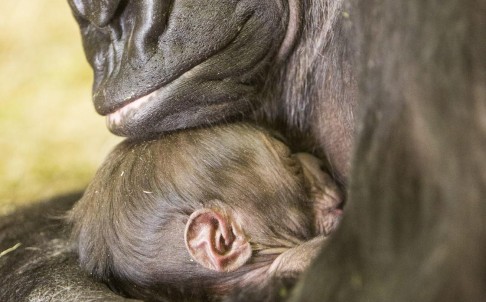Gorillas identified by scientists as source of lethal HIV virus strain
PUBLISHED : Tuesday, 03 March, 2015, 11:28pm
UPDATED : Tuesday, 03 March, 2015, 11:28pm
Tribune News Service

A western lowland gorilla and baby at a Chicago zoo.Photo: EPA
Western lowland gorillas in southern Cameroon appear to be the source for the second-most-lethal category of HIV that crossed into humans, a new study suggests.
The category of immunodeficiency virus, called HIV-1 group O, has not been nearly as dangerous to humans as group M, which has infected more than 40 million people worldwide. But its origin and history had been a mystery.
Using nearly 3,000 faecal samples from gorillas in several western and central African countries, researchers reported on Monday that they pinpointed the source population for group O, which has infected 100,000 people in west-central Africa, and for the exceedingly rare group P, which infected only two people.
The simian viruses identified by researchers leaped from chimpanzees to the gorillas, which spread it at least twice to humans, according to the study, published online in the journal Proceedings of the National Academy of Sciences.
"The gorilla virus is basically a chimp virus in gorillas," said co-author Dr Beatrice Hahn of the University of Pennsylvania, who has been studying chimpanzee versions of the simian immunodeficiency virus, SIV, for 20 years.
Researchers had already traced the main HIV-1 lineage, group M, to SIV in chimpanzees, which transmitted it several times to humans. The origin of the very rare group N, which infected about a dozen people, likewise has been found.
Why group O did not spread more readily between chimpanzees and western lowland gorillas, which share habitat, is of great interest to researchers looking to combat the pathogen.
"Gorillas and chimps live in the same forest; they probably see each other more often than humans see them," said Hahn. "And yet, there is only evidence for a single transmission."
Even though SIV is just as common among eastern chimps sharing habitat with eastern lowland gorillas, there was no evidence it leapt from one species to the other. Only western lowland gorillas harboured the SIV that apparently spread from central chimpanzees.
"It seems that they have a mutation that makes the chimpanzee viruses have a lot of difficulties adapting to this host," said lead investigator, Martine Peeters, a virologist at Montpellier University, in France.
The infection among western lowland gorillas was spread over nearly 400km, only in their northernmost range - southern Cameroon. Researchers are not sure if geographic barriers prevent spread or if the distribution is the result of overall population decline of gorillas, due to human incursion and factors including infection from Ebola.
But SIV itself could be fuelling the decline - researchers don't know if SIV eventually leads to an AIDS-like disease, as it does among chimpanzees. That will be the researchers' next line of investigation, they said.
